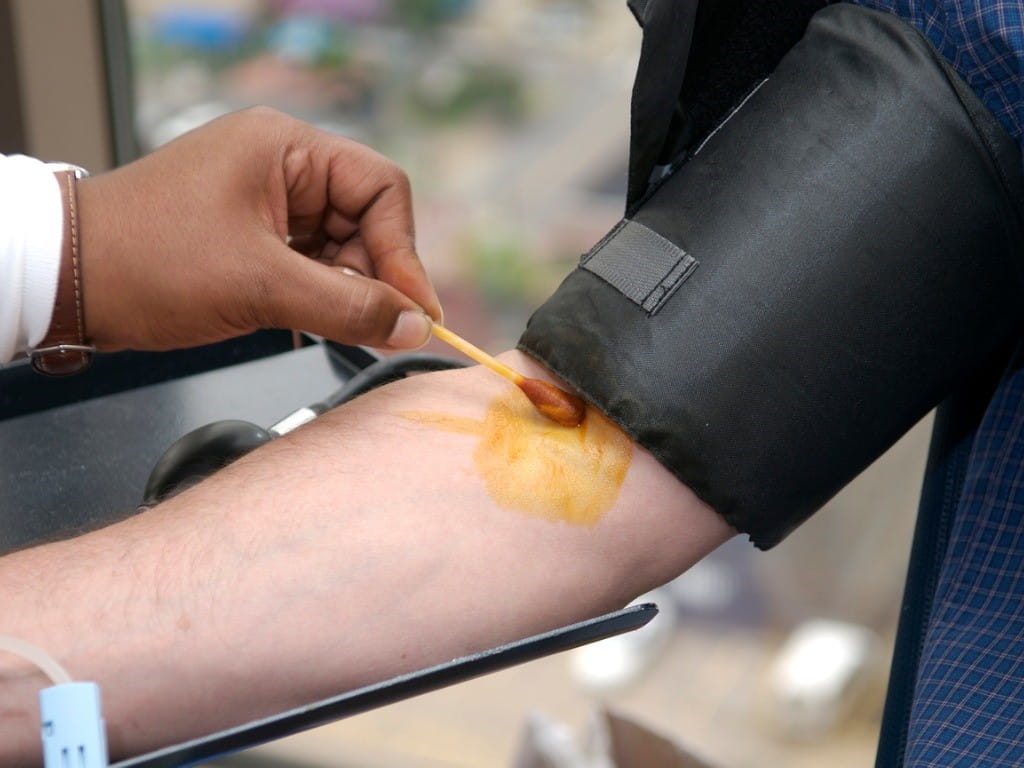Povidone - iodine
Safe Use of a Common Antiseptic

The Bottom Line
Povidone is found in both medical and household items and can cause mild symptoms with large ingestions. Povidone iodine is a common antiseptic used to disinfect the skin, eyes, and vagina. When used correctly, povidone iodine might cause mild side effects, but it can cause major problems when used incorrectly.

The Full Story
Povidone, also known as polyvinylpyrrolidone (PVP), was originally developed in Germany as a plasma expander, intended for use by the German military in World War II. Povidone was later found to be ineffective as a blood substitute, and is no longer used for this purpose. Because it dissolves easily in multiple substances, it is now commonly used in the pharmaceutical and cosmetic industries. Other chemical characteristics of povidone, including its biological inertness and ability to bind and form complexes with other materials, make povidone a favorable compound for use in many industries today. Povidone is an ingredient in many artificial tear and eye lubricating products. Some contact lens manufacturers even incorporate povidone into their lens to act as a wetting agent to increase moisture retention. Povidone is also used as a binder in medication tablets and in liquid oral drugs. You can frequently find it listed in cosmetic products such as hair spray, lipstick, gels, and shampoos. Povidone is even used in toothpaste, as a stain remover and whitening ingredient.
Large ingestions of povidone are expected to cause only minimal symptoms such as diarrhea. If povidone gets into the eyes or onto the skin, it might cause irritation and pain. There have been reports of severe allergic reactions occurring in sensitive people, but this reaction is rare. Symptoms of a severe allergic reaction include wheezing; difficulty breathing; dizziness; chest tightness; hives; and swelling of the lips, face, tongue, or throat. If these symptoms occur, call 911 immediately regardless of the suspected cause.
Because of povidone’s chemical properties, it can reduce the irritating or toxic nature of other drugs when formulated as a combination product. Povidone is often combined with iodine for use as an antiseptic agent. This combination product is commercially available as the skin antiseptic Betadine®, but is also available in less concentrated forms for use in the eyes and vagina. In hospital settings, povidone iodine is often used as an antiseptic agent in surgical procedures. Recently, nasal and oral decontamination with povidone iodine has been recommended for healthcare workers as a preventive measure against COVID-19 infection. As the effectiveness of this treatment remains unclear, the use of povidone iodine for prevention of COVID-19 remains experimental at this time.
Common side effects seen with both povidone iodine eye drops and skin formulations may include local swelling, irritation, itching, and rash. With overuse, povidone iodine can have corrosive effects due to its iodine content. With eye exposures, patients should irrigate the eyes for 15 minutes immediately after an exposure. Any persistent eye pain or symptoms might need medical examination and treatment. Ingestion can cause stomach upset, thyroid dysfunction, and burns of the gastrointestinal tract. In severe cases, heart and kidney failure may occur. The poisonous effects that can occur are due to iodine toxicity and often require specialized treatment in a hospital setting.
When used as directed for antiseptic purposes, povidone iodine is generally safe. Toxicity is most commonly seen when topical povidone iodine is used chronically and in large amounts. Certain populations, including patients with kidney dysfunction, and those with thyroid disorders, should speak with their healthcare provider prior to using povidone iodine because they might be more sensitive to the effects of povidone iodine.
If you have a question about poisoning from povidone iodine, get help online to www.poison.org or call 1-800-222-1222. Both options are free for the public, and available 24 hours a day.
Kelly Johnson-Arbor, MD
Medical Toxicologist
Poisoned?
Call 1-800-222-1222 or
Prevention Tips
- Keep all medications in child-resistant containers and stored away from children and pets.
- Keep povidone iodine in its original, labeled container at all times.
- Before using povidone iodine, read the Drug Facts section of the medication label carefully and be sure to understand and follow its instructions.
- Use as little as possible and never more than the amount specified on the label.
This Really Happened
Case 1. A 61-year-old woman called Poison Control after she meant to take a dose of cough medicine but unintentionally took a gulp of povidone iodine 10% solution instead. She soon developed throat irritation and vomited once. When Poison Control called back 7 hours later, her tongue was irritated and a little swollen, but she was otherwise feeling much better. A day later, all symptoms had resolved.
Case 2. A nursing home called Poison Control because a 71-year-old woman grabbed a cup that contained Betadine and drank some thinking it was coffee. She drank about half a teaspoonful (2.5 mL). Immediately afterward, she had a few episodes of vomiting. When Poison Control followed up 3 hours later, her symptoms had resolved.
Case 3. An ER physician called Poison Control regarding a 38-year-old man who had swallowed a tablespoonful of Betadine 10% solution mistaking it for medication. He vomited a few times at home. In the ER, his main complaints were throat irritation and nausea. He was given anti-nausea medication and crackers and was watched in the ER. Poison Control followed up with him at home the next day, and all of his symptoms had resolved.
For More Information
Povidone iodine solution [Internet]. Drugs.com [cited 29 Aug 2019].
References
Kostrzewska E. Blood substitutes. Ann R Coll Surg Engl. 1976 Mar;58(2):115-25.
Poisoned?
Call 1-800-222-1222 or
Prevention Tips
- Keep all medications in child-resistant containers and stored away from children and pets.
- Keep povidone iodine in its original, labeled container at all times.
- Before using povidone iodine, read the Drug Facts section of the medication label carefully and be sure to understand and follow its instructions.
- Use as little as possible and never more than the amount specified on the label.
This Really Happened
Case 1. A 61-year-old woman called Poison Control after she meant to take a dose of cough medicine but unintentionally took a gulp of povidone iodine 10% solution instead. She soon developed throat irritation and vomited once. When Poison Control called back 7 hours later, her tongue was irritated and a little swollen, but she was otherwise feeling much better. A day later, all symptoms had resolved.
Case 2. A nursing home called Poison Control because a 71-year-old woman grabbed a cup that contained Betadine and drank some thinking it was coffee. She drank about half a teaspoonful (2.5 mL). Immediately afterward, she had a few episodes of vomiting. When Poison Control followed up 3 hours later, her symptoms had resolved.
Case 3. An ER physician called Poison Control regarding a 38-year-old man who had swallowed a tablespoonful of Betadine 10% solution mistaking it for medication. He vomited a few times at home. In the ER, his main complaints were throat irritation and nausea. He was given anti-nausea medication and crackers and was watched in the ER. Poison Control followed up with him at home the next day, and all of his symptoms had resolved.
